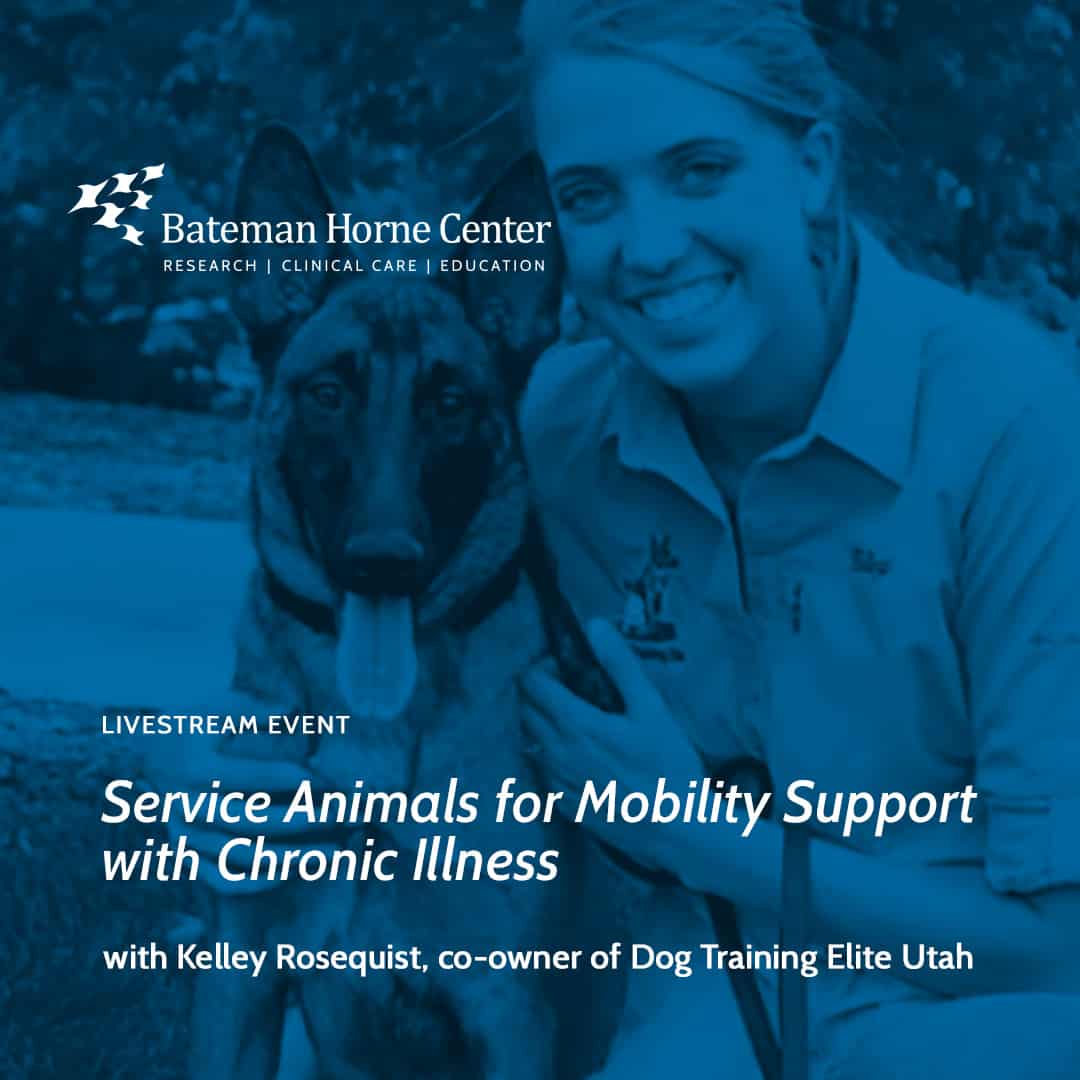 August’s education meeting featured Kelley Rosequist, owner of Dog Training Elite Utah. She provided information on service dogs and specifically on how service dogs can provide mobility support for those with fibromyalgia, ME/CFS and other chronic illnesses.
August’s education meeting featured Kelley Rosequist, owner of Dog Training Elite Utah. She provided information on service dogs and specifically on how service dogs can provide mobility support for those with fibromyalgia, ME/CFS and other chronic illnesses.
What Makes a Service Animal?

Different subsets of service dogs help with different tasks, including mental health, PTSD, mobility support, medical alerts (for instance, alerting handlers and emergency services to asthma attacks or seizures), autism support, vision support, and hearing support.
Since service dogs require specific and reliable skills, they go through a long training process. Initial training takes one to two years, and ongoing training happens daily. This training includes staying obedient, calm, and focused in any environment. The process also includes task-specific training—for example, an asthma alert service dog is taught to monitor breathing patterns and nudge their handler’s chest if the breathing pattern changes.
Mobility Support Service Dogs
Service dogs trained in mobility support provide important help to physically disabled people, including people with fibromyalgia and ME/CFS. These dogs provide increased independence by helping their handlers perform such tasks as reaching items, pushing elevator buttons, and picking things up from the floor. Because of this, people can live more independently, and can sometimes even live alone where they could not before.
Mobility support service dogs also provide other aid. Handlers can better access their communities when dogs assist them in public transit. Concerning safety, service dogs can trigger medical alert buttons, get help from a neighbor, and brace falls. They can also provide further medical assistance by carrying oxygen bags, pulling wheelchairs, and reminding handlers to take their medications. Finally, service dogs can stabilize movement by helping handlers up stairs, pulling handlers out of chairs, and letting handlers lean a lot of their weight on the dog.
Common mobility tasks include: picking up items from the floor, bracing handlers, helping handlers in and out of chairs and vehicles, opening doors, turning lights on and off, fetching caregivers or medical professionals, and navigating crowded spaces.
While the main job of these service animals is task-specific mobility support, caring for a dog also provides secondary benefits. These include: companionship, improved sleep habits, better socialization, better routines, greater confidence as those sick become caregivers, and unconditional love.
Considering a Service Animal?
There are many benefits to a mobility support service dog; there are also many factors to take into consideration. First, it takes about two years to train a dog to your needs, and there may be long wait lists, especially for nonprofit organizations. Therefore, if you need a dog, apply as soon as possible.
Second, the dog breed is an important factor to consider. Best to research and speak with service animal training organizations for their best recommendations based on energy level and attention span. ME/CFS and FM patients most likely won’t fair well with Labrador Retrievers and Golden Retrievers, since these breeds require more attention and energy. Other breeds such as Great Danes might be better suited to those with energy restrictions.
Third, dog training directly with the handler is important since it increases bonding and helps the dog become more attuned to your needs. Sometimes buying a fully-trained dog is the right decision, especially for people who can’t handle the energy and maintenance required for training with a puppy. However, if family and friends can help, it is the best case scenario for the dog owner to take an active role in the training of their service dog. It is possible for everyone, from young children to old adults, to help train a service dog.
Lastly, the age of the dog matters. An older dog may only be able to act as a service dog for a few years before retiring. Younger dogs are also better at supporting someone’s weight. No matter the age, a service dog will need around 1-2 hours of daily training.
Dog Training Elite, located in Salt Lake City, is always happy to help people with questions and resources about service dogs, regardless of geographic location. Contact Dog Training Elite via email here or call or 801.266.4802. We are grateful for Kelley Rosequist donating her time to present this information.
If this content has been useful to you or a loved one, we invite you to check out our free online class series, explore our video library, and subscribe to our monthly newsletter. We thank you for your continued support as we aim to improve today’s quality of life for ME/CFS and Fibromyalgia patients everywhere.
Please consider making a donation to BHC, a 501 (c)3 nonprofit organization today.

 Lucinda Bateman, MD, is a renowned clinician, researcher, and educator. Her Johns Hopkins University Medical School training instilled an approach to care that she has employed throughout her career - the patient comes first and the unknown or unexplained does not equate to a lack of proper and compassionate care. Since starting her own practice in 2000, she has served on six boards or committees, been the principal investigator for 45 studies, authored/coauthored 40 journal articles, served as adjunct instructor and adjunct assistant professor in the University of Utah Departments of Preventative Medicine, Internal Medicine, and Anesthesiology, and lectured around the world.
Lucinda Bateman, MD, is a renowned clinician, researcher, and educator. Her Johns Hopkins University Medical School training instilled an approach to care that she has employed throughout her career - the patient comes first and the unknown or unexplained does not equate to a lack of proper and compassionate care. Since starting her own practice in 2000, she has served on six boards or committees, been the principal investigator for 45 studies, authored/coauthored 40 journal articles, served as adjunct instructor and adjunct assistant professor in the University of Utah Departments of Preventative Medicine, Internal Medicine, and Anesthesiology, and lectured around the world.